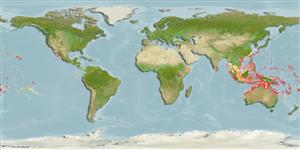>
Eupercaria/misc (Various families in series Eupercaria) >
Scaridae (Parrotfishes) > Scarinae
Etymology: Scarus: Greek, skaros = a fish described by anciente writers as a parrot fish; 1601 (Ref. 45335).
Eponymy: Hermann Schlegel (1804–1884) was a German-born zoologist who spent much of his life in the Netherlands. [...] (Ref. 128868), visit book page.
More on author: Bleeker.
Environment: milieu / climate zone / depth range / distribution range
Sinh thái học
Biển Cùng sống ở rạn san hô; Mức độ sâu 1 - 50 m (Ref. 37816). Tropical; 30°N - 28°S, 94°E - 124°W
Pacific Ocean: Cocos (Ref. 9399) and Christmas (Ref. 30874) islands in the eastern Indian Ocean; then from Moluccas to the Tuamoto and Austral islands, north to the Ryukyu Islands, south to Shark Bay and the southern Great Barrier Reef and Rapa.
Bộ gần gũi / Khối lượng (Trọng lượng) / Age
Maturity: Lm ? range ? - ? cm
Max length : 40.0 cm TL con đực/không giới tính; (Ref. 9137); 30.0 cm TL (female)
Các tia vây lưng cứng (tổng cộng) : 9; Các vây lưng mềm (tổng cộng) : 10; Tia cứng vây hậu môn: 3; Tia mềm vây hậu môn: 9. Scales large. 4 median predorsal scales; 2 scale rows on cheek. Caudal fin slightly rounded in initial phase, retained in terminal males with protruding lobes giving a double emarginate effect. Lips cover or nearly cover dental plates. Initial-phase fish without canines; terminal males usually with 1 upper canine and 2 on lower. The initial phase is characterized by a series of irregular dark chevrons which may be difficult to see on dark individuals (Ref. 1602). The basic color may range from a pale gray to a deep mahogany (Ref. 1602). Large initial phase fish develop the dark greenish markings around the lip found in the terminal phase (Ref. 1602).
Inhabits lagoon and seaward reefs from 1 to over 50 m depth. Adults are common in areas with rich coral and high vertical relief (Ref. 9710, 48636). A solitary species (Ref. 90102). Juveniles may school with other species. Form feeding aggregations on rubble and mixed rubble-coral slopes rather than on flats. Females often in schools of mixed species when feeding, males usually seen separate (Ref. 48636). Feeds on benthic algae (Ref. 89972). Males exhibit territorial tendencies.
Life cycle and mating behavior
Chín muồi sinh dục | Sự tái sinh sản | Đẻ trứng | Các trứng | Sự sinh sản | Ấu trùng
Oviparous, distinct pairing during breeding (Ref. 205).
Randall, J.E., G.R. Allen and R.C. Steene, 1990. Fishes of the Great Barrier Reef and Coral Sea. University of Hawaii Press, Honolulu, Hawaii. 506 p. (Ref. 2334)
IUCN Red List Status (Ref. 130435: Version 2024-1)
Threat to humans
Harmless
Human uses
Các nghề cá: Tính thương mại; Bể nuôi cá: Tính thương mại
Các công cụ
Special reports
Download XML
Các nguồn internet
Estimates based on models
Preferred temperature (Ref.
123201): 24.5 - 28.8, mean 27.6 °C (based on 432 cells).
Phylogenetic diversity index (Ref.
82804): PD
50 = 0.5000 [Uniqueness, from 0.5 = low to 2.0 = high].
Bayesian length-weight: a=0.01660 (0.01093 - 0.02521), b=3.03 (2.91 - 3.15), in cm total length, based on LWR estimates for this species & Genus-body shape (Ref.
93245).
Mức dinh dưỡng (Ref.
69278): 2.0 ±0.0 se; based on diet studies.
Thích nghi nhanh (Ref.
120179): Trung bình, thời gian nhân đôi của chủng quần tối thiểu là 1.4 - 4.4 năm (K=0.22).
Fishing Vulnerability (Ref.
59153): Low to moderate vulnerability (32 of 100).
Nutrients (Ref.
124155): Calcium = 36.2 [23.6, 62.3] mg/100g; Iron = 0.715 [0.503, 1.097] mg/100g; Protein = 18.5 [16.5, 20.3] %; Omega3 = 0.0925 [, ] g/100g; Selenium = 20.5 [12.5, 32.8] μg/100g; VitaminA = 53.7 [16.6, 172.4] μg/100g; Zinc = 2.23 [1.68, 2.88] mg/100g (wet weight);
